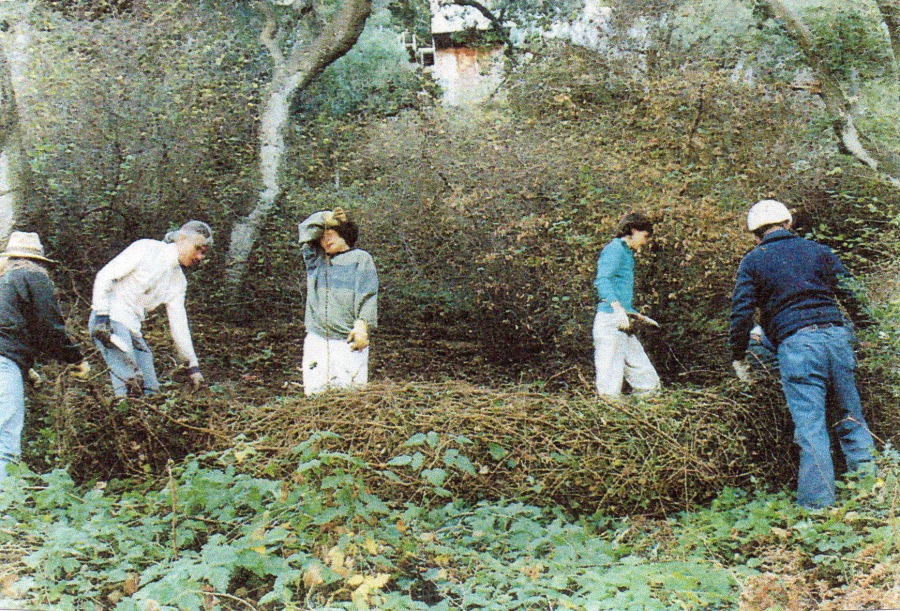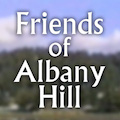According to Thelma Rubin, an original member as well as a former Albany city council member and mayor, Friends of Albany Hill seems to have started in 1974, when nine residents (including Thelma Rubin, Dario Meniketti, and Catherine Webb) of Albany Hill brought a lawsuit against the city of Albany, councilman Hubert Red Call and his wife Ruth Call, four other council members, and a development company, Interstate General Development Corporation. Councilman Call had sold 1.1 acres of his Albany Hill land to IGD for $258,000, and IGD then donated the land to the city. The citizens alleged the land Call sold to IGD was overpriced and the transaction was a conflict of interest, since Call was an elected official. IGD was building the Gateview condominium towers on the west side of the hill at the time.
Peter Taussig, a lawyer who lived on Albany Hill, handled the case pro-bono, with Friends of Albany Hill paying legal fees.The suit went through many courts and IGD and Call filed counter-suits against the city and the nine plaintiffs. Rubin recalled that, although she was being sued for one million dollars, she and her husband were still able to receive a car loan they applied for.
In 1985 the California Supreme Court ruled in favor of the nine citizens and ordered Call to pay the city the amount he received from the sale of his land plus interest.
Fighting development and preserving the hill in the 1990’s
In 1989 Carole Fitzgerald, an artist living near Albany Hill since 1973, came back from a rain forest benefit and read in a local paper that a developer was going to cut down over 80 eucalyptus trees and oaks on the east side of the hill. “And I thought, You know, it’s time to take care of your own backyard,” she told an interviewer for an Express article in 1992.
She became involved with Citizens to Protect Albany Hill, a group of people who lived on Albany Hill who were fighting the development on steep land between Taft Ave. and Jackson Street. LandVest had obtained approval from the Planning & Zoning Commission to build 37 units on the parcel on the east side of the hill. Fitzgerald, Guy Chambers, Matthew Rinaldi, Marge Zimmerman, and others went to planning commission and city council meetings to speak out against the development. The city determined that LandVest’s proposal failed to comply with building and permit requirements and took away its permit. LandVest sued the city, but lost the case and ran out of money.
In 1992 Carole Fitzgerald reactivated Friends of Albany Hill, which had been dormant since 1978, when it fought a previous development scheme along Taft on Albany Hill.
In June 1992, after meeting with the Trust for Public Land, Fitzgerald opened the Save Albany Hill Trust Fund through the Sierra Club Foundation in order to fundraise for purchase of remaining open space, fund stewardship projects, and initiate public education about the cultural, historical, and natural diversity of Albany Hill.
Fitzgerald organized several events to increase awareness of Albany Hill and to fundraise for the trust fund. In June 1992 she organized a seminar called “Stewardship of Albany Hill”, which was held at Albany Middle School and featured lectures, poetry, art, and music on birds, monarchs, cultural resources, and stewardship on the hill, followed by a tour of Albany Hill.
Monarch scientist John Lane spoke about the monarch migration, anthropologist George Cole spoke about the cultural resources on the hill, creek advocate John Steere talked about creek restoration and read his creek poetry, architect Gary Mason made a presentation about the Albany Hill/Creekside Park Master Plan and Vegetation Management Plan, Cynthia Hall of the Trust for Public Land, Lisa Stampfli-Torme of Citizens for Oakland Open Space, and Fitzgerald led a forum on coalition building, and singer-songwriter Judith Freedman sang environmentally inspired songs.
Friends of Albany Hill sponsored an “Albany Hill Celebration” at Gathering Tribes on Solano Ave. in December 1993, displaying Carole Fitzgerald’s watercolors of nature on Albany Hill. Peter Berg and Sabrina Merlo of Planet Drum, John Steele of East Bay Citizens for Creek Restoration, Gary Mason of Wolf-Mason Architects (the firm that compiled the Albany Hill/Creekside Park Master Plan in 1991), and Fitzgerald held a creek workshop. Malcolm Margolin, publisher of Heyday Books, shared stories about Native Californian culture and the importance of nature on the hill and along the creek. And Michelle Vendiola, a Native American woman, born on the San Juan Islands, presented a lecture and video about indigenous people and the environment.
Density limitations and land purchases
Albany voters passed an ordinance in 1994, known as Measure K, that cut housing density by half on the hill from the amount approved in 1978 under Measure D.
A statewide ballot measure, called the California Parks and Wildlife Initiative or CALPAW, was on the ballot in 1994 and would have designated bond money to purchase threatened land and wildlife habitat and restore existing parkland and recreational facilities. Fitzgerald, on behalf of the Friends of Albany Hill submitted a request to have Albany Hill included as a project and Albany had an earmark of $5 million to use toward the purchase of private land on Albany Hill, but the ballot measure did not pass.
In 1995 the city bought the half-acre Able/Lemmon parcel beyond the end of Madison St. with funds from the city and from a 1985 settlement in a conflict-of-interest lawsuit that Friends of Albany Hill brought against a former council member (see above). Friends of Albany Hill held a dedication ceremony for the parcel as a pedestrian gateway to Albany Hill.
Friends of Albany Hill lobbied in 1996 for a city advisory measure, known as Measure R, in which 50 percent of revenues from an assessment district would be earmarked for purchase of undeveloped land on Albany Hill as well as for improvement projects on the hill. The other 50% would go toward construction of athletic fields and restoration of Albany’s creeks. Albany voters approved the measure.
A one-acre parcel at the end of Madison Street, owned by Willis, would require costly capital improvements to be developed, including sewer lines, curbs, and utilities. Using Measure R funds the city purchased the parcel in 1998.
The city bought two more parcels with Measure R funds in 1999: the four-acre Burke parcel between Taft and Jackson (formerly the property of LandVest) and the one-acre Land’s End parcel, also located between Taft and Jackson.

Stewardship of the hill
Carole Fitzgerald obtained and managed California ReLeaf/National Urban Forestry grants in 1995 and 1996 to fund vegetation management on Albany Hill. The grants matched money for each hour of volunteer labor. Ivy and other non-native vines were removed from around and on the trunks of oaks and other native trees, stands of fennel and French broom were removed, and 19 eucalyptus trees invading the oak forest on the north side of the hill were removed

Barbara Ertter got involved with Friends of Albany Hill in the early 1990’s. A botanist from UC Berkeley, she lived next to Albany Hill across Cerrito Creek and would hear frogs croaking and great horned owls hooting. On her explorations of the hill she found a surprising number of native plants–about one-fifth of the 655 native plants in the East Bay–given the hill’s location in the middle of an urban area with freeways on one side and houses and malls on its others sides. She compiled a list of plants on the hill as well as several books of pressed plants. She also led nature walks on the hill: here’s a video from one she led in 1995 as part of the dedication ceremony for the parcel purchased at the end of Madison St on the east side of the hil
As a plant expert she guided volunteers at monthly work parties on when, where, and how to remove non-native plants while allowing the natives already there to spread.
In 1998 Friends of Albany Hill co-sponsored a Stewardship Fair at U.C. Berkeley, where Dr. Peter Raven, internationally renowned botanist and conservationist, gave a talk about Earth Day and the importance of local stewardship efforts.
Friends of Albany Hill continued stewardship work days on the hill through the rest of the 1990’s and early 2000’s. Barbara Ertter, Carole Fitzgerald, Robert Langston, an entomologist, Gary Mason, and Tom Pehrson, an arborist, guided volunteers in tree care, learning about native plants, and fire debris removal.

Richard Beidleman, a Research Assistant at the UC and Jepson Herbaria, studied birds on the hill and compiled a list. He gave a lecture in Albany about his winter bird population survey on the hill and led numerous bird walks for the Friends of Albany Hill.
Robert Langston studied the butterflies and moths on Albany Hill after his retirement and guided volunteers at work parties on which plants were important to lepidopterans (butterflies and moths). He curated insects at the California Academy of Sciences. His and fellow entomologist Jerry Powell’s list of butterflies and moths is posted on this web site.
In 2001 Fitzgerald organized an event on the hill called “Celebrate Mother Earth,” in which Richard Beidleman led a bird walk, Barbara Ertter led a wildflower and native plant walk, and Fitzgerald held a plein air painting session.
With the help of a large donation from Art Schroeder of El Cerrito, Friends of Albany Hill hired Noah Booker of Shelterbelt Builders, Inc in the early 2000’s to restore native bunch grasses and wildflowers on the hill. The city currently contracts out only basic fire management of vegetation once a year, and as a result, many invasive plants have returned.
Dormancy
After years of energetic activities such as, campaigning for Measure R to provide a source of money for land purchases, Friends of Albany Hill went dormant for several years, although Fitzgerald held a few events. In conjunction with the California Monarch Campaign of the Xerces Society Friends of Albany Hill coordinated a monarch count on Thanksgiving Day in 2004.
In 2008 Fitzgerald organized an event on the hill as part of Albany’s centennial celebration. Barbara Ertter led a native plant walk, Alan Kaplan, retired EBRPD naturalist, led a bird walk, and Fitzgerald held a Thanksgiving count of monarch butterflies.
Also in 2009, and 2010, as part of the Martin Luther King, Jr. Day of Service, Friends of Albany Hill and the city of Albany coordinated a stewardship day on the hill, pulling broom and other invasive, fire-prone plants.
In 2016, Fitzgerald reorganized the Friends of Albany Hill. Ralph Pericoli has taken over the updating of our bird list and leads monthly bird walks. He is a registered Master Birder with the California Academy of Science. Peter Bergen of Petaluma teaches the Intro to Bird Language classes through the Albany Recreation Department. Margot Cunningham directs maintenance projects for the Albany Public Works until Measure R funds expire in 2019. She is no longer affiliated with FOAH as we are an all volunteer organization. Carole Fitzgerald continues organizing the Annual Monarch Thanksgiving Count with Bill Shepard and Mia Monroe of the Xerces Society, the annual Celebration of Albany Hill in December, and other educational programs.

